Drag queen
A drag queen is a person, usually male, who uses drag clothing and makeup to imitate and often exaggerate female gender signifiers and gender roles for entertainment purposes. Historically, most drag queens have been men dressing as women. In modern times, drag queens are associated with gay men and gay culture, but they can be of any gender and sexual identity.
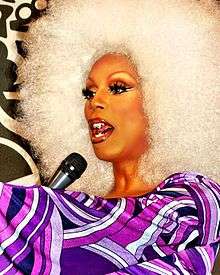
| Cross-dressing |
|---|
|
|
Key elements |
|
Modern drag culture |
|
Sexual aspects
|
|
Other aspects |
|
Passing as male |
|
Passing as female
|
|
Books
|
.jpg)
People partake in the activity of doing drag for reasons ranging from self-expression to mainstream performance. Drag shows frequently include lip-syncing, live singing, and dancing. They occur at events like gay pride parades and drag pageants and in venues such as cabarets and nightclubs. Drag queens vary by type, culture, and dedication, from professionals who star in films to people who do drag only occasionally.
Terminology, scope and etymology
The origin of the term drag is uncertain;[1] the first recorded use of drag in reference to actors dressed in women's clothing is from 1870.[2] For much of history, drag queens were men, but in more modern times, cisgender and trans women, as well as non-binary people, also perform as drag queens.[3][4][5][6] In a 2018 article, Psychology Today stated that drag queens are "most typically gay cisgender men (though there are many drag queens of varying sexual orientations and gender identities)".[7] Examples of trans female drag queens, sometimes called trans queens,[8] include Monica Beverly Hillz[3][4] and Peppermint.[5] Cisgender female drag queens are sometimes called faux queens or bioqueens, though both terms are problematic: faux carries the connotation that the drag is fake, and the use of bioqueen exclusively for cisgender females is a misnomer since trans female queens also have female bodies.[9][10] Drag queens' counterparts are drag kings: performers, usually women, who dress in exaggeratedly masculine clothing. Trans men who dress like drag kings are sometimes termed trans kings.
Female impersonator
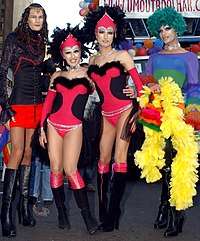
Another term for a drag queen is female impersonator.[11] Female impersonation has been and continues to be illegal in some places, which inspired the drag queen José Sarria to hand out labels to his friends reading, "I am a boy", so he could not be accused of female impersonation.[12] American drag queen RuPaul once said, "I do not impersonate females! How many women do you know who wear seven-inch heels, four-foot wigs, and skintight dresses?" He also said, "I don't dress like a woman; I dress like a drag queen!"[13]
Alternative terms
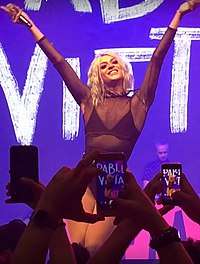
Some drag queens may prefer to be referred to as "she" while in drag and desire to stay completely in character.[15] Other drag performers, like RuPaul, seem to be completely indifferent to which pronoun is used to refer to them. In his words, "You can call me he. You can call me she. You can call me Regis and Kathie Lee; I don't care! Just so long as you call me."[16]
Drag queens are sometimes called transvestites, although that term also has many other connotations than the term drag queen and is not much favored by many drag queens themselves.[17] The term tranny has been adopted by some drag performers, notably RuPaul,[18] and the gay male community[19] in the United States, but it is considered offensive to most transgender and transsexual people.[20]
Many drag performers refer to themselves as drag artists, as opposed to drag queens, as some contemporary forms of drag have become nonbinary.[21][22]
Uncommon terms
In the drag queen world today, there is an ongoing debate about whether transgender drag queens are actually considered "Drag Queens". Some argue that, because a drag queen is defined as a man portraying a woman, transgender women cannot be drag queens. Drag Kings are biological females who assume a masculine aesthetic. However this is not always the case, because there are also biokings, bio-queens, and faux queens, which are people who perform their own biological sex through a heightened or exaggerated gender presentation.[23][24][25]
History of drag
America
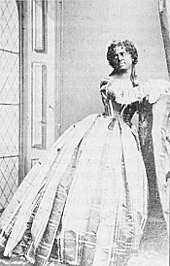
Minstrel shows
Development of the drag queen in the United States was influenced by the development of the blackface minstrel show.[26] Originally the performers would only mock African American men, but as time went on they found it amusing to mock African American femininity as well. They performed in comedic skits, dances, and "wench" songs.[27][27]
Canada
In the 1940s John Herbert, who sometimes competed in drag pageants, was the victim of an attempted robbery while he was dressed as a woman.[28][nb 1] His assailants falsely claimed that Herbert had solicited them for sex,[28] and Herbert was accused and convicted of indecency[28] under Canada's same-sex sexual activity law (which was not repealed until 1969). After being convicted, Herbert served time in a youth reformatory in Guelph, Ontario.[29][31][32][nb 2] Herbert later served another sentence for indecency at reformatory in Mimico.[28] Herbert wrote Fortune and Men's Eyes in 1964 based on his time behind bars.[32] He included the character of Queenie as an authorial self-insertion.[28]
In 1973 the first Canadian play about and starring a drag queen, Hosanna by Michel Tremblay, was performed at Théâtre de Quat'Sous in Montreal.[33]
In 1977 the Canadian film Outrageous!, starring drag queen Craig Russell, became one of the first gay-themed films to break out into mainstream theatrical release.
In 1980, for the first time, a police presence protected gay spectators and drag queens from anti-gay harassment at the annual Hallowe'en show at Toronto's St. Charles Tavern.
Europe
Pantomime dames
In the late 1800s to the mid-1900s, pantomime dames became a popular form of female impersonation in Europe.[34] This was the first era of female impersonation in Europe to use comedy as part of the performance, contrasting with the serious Shakespearean tragedies and Italian operas.[35] The dame became a stock character with a range of attitudes from "charwoman" to "grande dame" that mainly was used for improvisation.[35] The most famous and successful pantomime dame was Dan Leno. After World War I and World War II, the theatre and movie scenes were changing, and the use of pantomime dames declined.[34]
First drag balls
The first person to describe himself as "the queen of drag" was William Dorsey Swann, who in the 1880s started also hosting drag balls attended by other men who were former slaves, and often raided by the police, as documented in the newspapers.[36] In 1896, Swann was convicted and sentenced to 10 months in jail on the false charge of "keeping a disorderly house" (euphemism for running a brothel) and demanded a pardon from the president for holding a drag ball (the demand was denied).[36]
Vaudeville and female impersonators
.jpg)
The broad comedic stylings of the minstrel shows helped develop the vaudeville shows of the late 1800s to the early 1900s.[26] With this shift, the "wench players" became "prima donnas", and became more elegant and refined, while still retaining their comedic elements.[27] While the "wenches" were purely American creations, the "prima donnas" were inspired by both America and European cross-dressing shows, like Shakespearean actors and castrati.[27] With the United States shifting demographics, including the shift from farms to cities, Great Migration of African Americans, and an influx of immigrants, vaudeville's broad comedy and music expanded the audience from minstrelsy.[26]
With vaudeville becoming more popular, it allowed female impersonators to become popular as well. Many female impersonators started with low comedy in vaudeville and worked their way up to perform as the prima donna.[34] They were known to perform song and dance routines with multiple outfit changes.[26] In New York City, famous female impersonator Julian Eltinge found success, and he eventually made his way to the Broadway stage performing as a woman.[34] He published a magazine, Magazine and Beauty Hints (1913), which provided beauty and fashion tips, and he posed for corset and cosmetics advertisements.[26] Meanwhile, in San Francisco, Bothwell Browne was the top female impersonator of the West Coast. He performed at the Grand Opera House and Central Theater, among other venues, went on tour with United Vaudeville, and later appeared in the film Yankee Doodle in Berlin (1919), produced by Mack Sennett.[37]
At this time being a female impersonator was seen as something for the straight white male, and any deviation was punished.[26] Connection with sex work and homosexuality eventually lead to the decline of vaudeville during the Progressive Era.[26] Both the minstrelsy and vaudeville eras of female impersonation led to an association with music, dance, and comedy that still lasts today.[34]
Night clubs
In the early to mid-1900s, female impersonation had become tied to the LGBT community and thus criminality, so it had to change forms and locations.[26] It moved from being popular mainstream entertainment to something done only at night in disreputable areas, such as San Francisco's Tenderloin.[26] Here female impersonation started to evolve into what we today know as drag and drag queens.[35] Drag queens such as José Sarria[38] and Aleshia Brevard[39] first came to prominence in these clubs.[26] People went to these nightclubs to play with the boundaries of gender and sexuality and it became a place for the LBGT community, especially gay men, to feel accepted.[40] As LGBT culture has slowly become more accepted in American society, drag has also become more, though not totally, acceptable in today's society.[35]
Protests
The Cooper Donuts Riot was a May 1959 incident in Los Angeles in which drag queens, lesbians, transgender women, and gay men rioted; it was one of the first LGBT uprisings in the United States.[41]
The Compton's Cafeteria riot, which involved drag queens and others, occurred in San Francisco in 1966.[42] It marked the beginning of transgender activism in San Francisco.[42]
On March 17, 1968, in Los Angeles, to protest entrapment and harassment by the LAPD, two drag queens known as "The Princess" and "The Duchess" held a St. Patrick's Day party at Griffith Park, a popular cruising spot and a frequent target of police activity. More than 200 gay men socialized through the day.[43]
Drag queens were also involved in the Stonewall riots, a series of spontaneous, violent demonstrations by members of the LGBT community against a police raid that took place in the early morning hours of June 28, 1969, at the Stonewall Inn, located in the Greenwich Village neighborhood of Manhattan, New York City. The riots are widely considered to be the catalyst for the gay liberation movement and the modern fight for LGBT rights in the United States.[44][45]
During the summer of 1976, a restaurant in Fire Island Pines, New York, denied entry to a visitor in drag named Terry Warren. When Warren's friends in Cherry Grove heard what had happened, they dressed up in drag, and, on July 4, 1976, sailed to the Pines by water taxi. This turned into a yearly event where drag queens go to the Pines, called the Invasion of the Pines.
Story time in libraries
In December 2015, Radar Productions and Michelle Tea developed the concept of Drag Queen Story Hour.[46] Launched at the San Francisco Public Library, Drag Queen Story Hour was adopted by the Brooklyn Public Library in the summer of 2016, and has since traveled to various libraries, museums, bookstores, and recreation centers, and parks across the United States, Canada, and the United Kingdom.[47] Such events sometimes prompt opposition against the libraries and organizers.[48][49]
India
On 6 September 2018, the Supreme Court of India ruled that the application of Section 377 of the Indian Penal Code to consensual homosexual sex between adults was unconstitutional, "irrational, indefensible and manifestly arbitrary".[50] Since then, drag culture in India has been growing and becoming the mainstream art culture. The hotel chain of Lalit Groups spaced a franchise of clubs where drag performances are hosted in major cities of India such as Mumbai, Delhi and Banglore. Maya the drag queen,[51] Rani Kohinoor (Sushant Divgikar),[52] Lush Monsoon,[53][54] Betta Naan Stop,[55] Tropical Marca,[56] Zeeshan Ali[57] and Patruni Chidananda Sastry [58] are some of the Indian drag artists.
Drag queen names
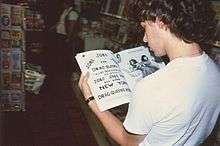
A drag queen may either pick or be given a drag name by a friend, sometimes called a "drag mother", the so named thus becoming known as a "drag daughter".[59] Drag mothers and drag daughters have a mentor-apprentice relationship. Drag families are a part of ball culture and drag 'houses'’.[60]
Art of drag
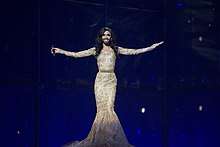
The process of getting into drag or into character can take hours. A drag queen may aim for a certain style, celebrity impression, or message with their look. Hair, make-up, and costumes are the most important essentials for drag queens.[61] Drag queens tend to go for a more exaggerated look with a lot more makeup than a typical feminine woman would wear.
Some people do drag simply as a means of self-expression,[62][63] but often drag queens (once they have completed a look) will go out to clubs and bars and perform in a "drag show."[64] Many drag queens do dress up for money by doing different shows, but there are also drag queens that have full-time jobs but still enjoy dressing up in drag as a hobby.[65]
Many parts of the drag show, and of the drag queens' other intellectual properties, cannot be protected by intellectual property law. To substitute the lack of legal protection, drag queens revert to social norms in order to protect their intellectual property.[66]
In entertainment
Drag shows and venues
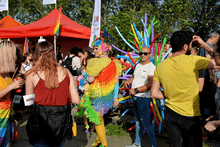
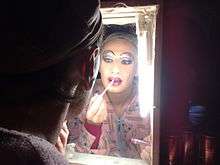
A drag show is a piece of entertainment consisting of a variety of songs, monologues or skits featuring either single performers or groups of performers in drag meant to entertain an audience.[67] They range from amateur performances at small bars to elaborately staged theatrical presentations.[68] Many drag shows feature performers singing or lip-synching to songs while performing a pre-planned pantomime, or dancing. The performers often don elaborate costumes and makeup, and sometimes dress to imitate various famous female singers or personalities. Some events are centered around drag, such as Southern Decadence where the majority of festivities are led by the Grand Marshals, who are traditionally drag queens.[69]
In film
- 1933 – Victor and Victoria, a German film about drag queens working in musical entertainment, starring Renate Müller and Hermann Thimig.
- 1933 – Arizona to Broadway, an American pre-Code film in which drag performer Gene Malin portrays Ray Best, a female impersonator and Mae West type, and performs the song "Frankie and Johnny."
- 1934 – George and Georgette, the French-language version of Victor and Victoria.
- 1935 – First a Girl, the English-language version of Victor and Victoria.
- 1937 – Upstairs (Piętro wyżej), the first Polish drag queen style movie, starring Eugeniusz Bodo.
- 1953 – Glen or Glenda, one of the most famous cult classics of Ed Wood, starring himself as Glen and Glenda.
- 1954 – White Christmas, classic of Irving Berlin, with Danny Kaye and Bing Crosby singing in "drag".
- 1957 – Victor and Victoria, a German remake of the 1933 film.
- 1959 – Some Like It Hot, starring Marilyn Monroe, Tony Curtis and Jack Lemmon.
- 1967 – Thoroughly Modern Millie, an American musical starring Julie Andrews, James Fox, Mary Tyler Moore, Carol Channing, John Gavin, and Beatrice Lillie, notable where Fox's character dresses in drag in order to find out what happened to Tyler Moore's character.
- 1969 – Funeral Parade of Roses starring Peter
- 1972 – Pink Flamingos starring Divine
- 1975 – The Rocky Horror Picture Show, with Tim Curry as a cross-dressing bisexual, Susan Sarandon, Barry Bostwick
- 1977 – Outrageous!, starring Craig Russell as a fictionalized version of himself
- 1978 – La cage aux folles a 1978 Franco-Italian film adaptation of the play of the same name starring Ugo Tognazzi and Michel Serrault.
- 1979 – The Rose starring Bette Midler, notable for a scene in which Midler's character Mary Rose Foster performs a duet on stage in a drag club with a drag queen (played by Kenny Sacha) who is impersonating Midler as Foster.
- 1982 – Tootsie starring Dustin Hoffman, Jessica Lange, and Teri Garr
- 1982 – Victor/Victoria, an American remake of the 1933 film, starring Julie Andrews
- 1985 – Lust in the Dust starring Divine
- 1988 – Hairspray starring Divine (Remade in 2007 starring John Travolta)
- 1988 – Torch Song Trilogy starring Harvey Fierstein, Anne Bancroft and Matthew Broderick
- 1990 – Paris Is Burning a documentary film directed by Jennie Livingston. It chronicles the ball culture of New York City and the gay and transgender community involved in it. It centers around African American and Latino drag culture surrounding communities such as Harlem in the 80s.
- 1991 – Vegas in Space starring Doris Fish, Miss X, Ginger Quest, and introducing 'Tippi'
- 1993 – Mrs. Doubtfire starring Robin Williams, Sally Field, and Pierce Brosnan.
- 1994 – The Adventures of Priscilla, Queen of the Desert starring Terence Stamp, Hugo Weaving, and Guy Pearce
- 1995 – To Wong Foo, Thanks for Everything! Julie Newmar starring Wesley Snipes, Patrick Swayze, and John Leguizamo (cameo by RuPaul)
- 1995 – Wigstock: The Movie documentary film focusing on the annual drag music festival that had been held in New York City's East Village during the 1980s and 1990s. Includes appearances by Lady Bunny, Crystal Waters, Deee-Lite, Jackie Beat, Debbie Harry, Leigh Bowery, Joey Arias and the Dueling Bankheads. The film also captures a performance by RuPaul at the height of his mainstream fame during the 1990s.[70]
- 1996 – The Birdcage starring Robin Williams, Nathan Lane, Gene Hackman and Dianne Wiest (a remake of the 1978 film La Cage aux Folles, based on the 1973 play)
- 1996 – The Nutty Professor starring Eddie Murphy.
- 1998 – Midnight in the Garden of Good and Evil starring John Cusack, Kevin Spacey and starring as herself Lady Chablis
- 1999 – Flawless starring Philip Seymour Hoffman and Robert De Niro
- 2000 – Big Momma's House starring Martin Lawrence
- 2001 – Hedwig and the Angry Inch starring John Cameron Mitchell
- 2002 – Sorority Boys
- 2002 – Miss 501: A Portrait of Luck
- 2003 – Girls Will Be Girls directed by Richard Day, starring Miss Coco Peru (Clinton Leupp), Evie Harris (Jack Plotnick), and Varla Jean Merman (Jeffery Roberson).
- 2003 – Die, Mommie, Die! starring Charles Busch, Jason Priestley, Philip Baker Hall, and Natasha Lyonne
- 2004 – Connie and Carla starring Nia Vardalos, Toni Collette, and David Duchovny
- 2004 – White Chicks starring Shawn Wayans and Marlon Wayans
- 2005 – Kinky Boots starring Joel Edgerton, Chiwetel Ejiofor, Sarah-Jane Potts, and Nick Frost
- 2005 – Rent
- 2006 – The Curiosity of Chance starring Tad Hilgenbrink and Brett Chukerman
- 2007 – St. Trinian's starring Rupert Everett as Camilla Fritton, the headmistress of the school.
- 2011 – Big Mommas: Like Father Like Son starring Martin Lawrence and Brandon T. Jackson
- 2012 – Albert Nobbs starring Glenn Close and Janet McTeer
- 2015 – Dressed as a Girl starring Johnny Woo
- 2016 – Absolutely Fabulous: The Movie starring Joanna Lumley and Jennifer Saunders, featuring Jodie Harsh and La Voix amongst others
- 2016 – Iru mugan (Indian Tamil movie) starring Vikram, Nayanthara, Nithya Menen and Nasser in the lead roles.
- 2016 – Hurricane Bianca starring Bianca Del Rio, Willam Belli, Shangela Laquifa Wadley and appearances by RuPaul, Joslyn Fox and Alyssa Edwards[71]
- 2018 – Hurricane Bianca 2: From Russia with Hate starring Bianca Del Rio, Rachel Dratch, Katya Zamolodchikova, Shangela Laquifa Wadley and appearances by Wanda Sykes, Mrs. Kasha Davis, Darienne Lake, Alaska Thunderfuck, Lady Bunny, and Alyssa Edwards
- 2019 – Drag Kids
- 2020 – Digging Up Dorothy is a short film featuring Darren Stewart-Jones as drag queen Ruby LaRue.
In music
While some male music celebrities wear exaggerated feminine clothing as part of their show, they are not necessarily drag queens. For example, Boy George wears drag queen style clothes and cosmetics but he once stated he was not a drag queen.[72] However, RuPaul is a professional drag queen performer and singer.[73]
Examples of songs where lyrics refer to drag queens:
- "Lola" by The Kinks (or possibly a transgender woman)
- "Dude (Looks Like a Lady)" by Aerosmith
- "The Lady Is a Vamp" by Spice Girls
- "Ballad of Cleo and Joe" by Cyndi Lauper
- "King for a Day" by Green Day
- "Cherry Lips" by Garbage
- "Born This Way" by Lady Gaga
- "Verbatim" by Mother Mother
- "He's a Woman, She's a Man" by Scorpions
- "Pretty Lady" by Ke$ha & Detox Icunt
- "Andrew in Drag" by The Magnetic Fields
- "Rise Like a Phoenix" by Conchita Wurst (represented Austria at the 2014 Eurovision Song Contest and won)
- "Divine" by Antony and the Johnsons
- "The End." in the album The Black Parade by My Chemical Romance
- "Drag Queen" by The Strokes
- "LGBT" by cupcaKke
- "C.L.A.T" by Aja, Peppermint, Sasha Velour and Alexis Michelle
In television
Drag queen Don McLean (drag name Lori Shannon)[74] appeared in three episodes of the CBS sitcom All in the Family as drag queen Beverly LaSalle: "Archie the Hero" (1975), in which Archie Bunker gives her mouth-to-mouth resuscitation, not realizing she is male; "Beverly Rides Again" (1976), in which Archie uses her to play a practical joke on a friend; and "Edith's Crisis of Faith, Part 1" (1977), in which her murder leads Edith Bunker to question her faith in God. The role was noteworthy for its uncommonly respectful and sympathetic treatment of Beverly as a "transvestite".[75][26][76]
CODCO was a Canadian sketch comedy series which aired on CBC Television from 1988 to 1993[77]; two of its actors, Tommy Sexton and Greg Malone, were especially renowned for drag-based impersonations of celebrity women such as Queen Elizabeth, Barbara Frum, Barbara Walters, Tammy Faye Bakker and Margaret Thatcher. In one famous sketch, Malone as Frum moderated a debate between Andy Jones as a gay teacher who had been fired from his job for testing HIV-positive and Sexton as Clarabelle Otterhead, the president of an anti-gay lobby group called Citizens Outraged by Weird Sex (or COWS).[78]
What Would You Do?, airing since early 2008, has had episodes featuring drag queens.[79][80]
In mid-2008, RuPaul began producing RuPaul's Drag Race, a reality television game show which began airing in February 2009. The premise of the program has several drag queens compete to be selected by RuPaul and a panel of judges as "America's next drag superstar". It inspired the similar spin-off shows RuPaul's Drag U and RuPaul's Drag Race: All Stars.
In 2018, American Idol featured a drag queen, Adam Sanders (drag name Ada Vox) as one of its contestants.[81] He made it to the top ten.[81]
In 2018, Celebrity Big Brother featured Queen Shane Jenek (drag name Courtney Act) as one of its contestants, placing first in the season with 49.43% of the public vote.[82]
Also in 2018, So You Think You Can Dance featured Jay Jackson (drag name Laganja Estranja) as one of its contestants.[83]
The Netflix show Dancing Queen, also released in 2018, starred Justin Johnson (drag name Alyssa Edwards) and his dance studio, Beyond Belief Dance Company.[84]
A 2018 episode of The Simpsons, titled “Werking Mom”, featured many drag queens, including cameos from RuPaul and Raja (the season three winner of RuPaul's Drag Race).[85]
Dragnificent! is a television series on the American network TLC. The show started as a special branded as Drag Me Down the Aisle which aired on March 9, 2019.[86] It features Alexis Michelle, BeBe Zahara Benet, Jujubee, and Thorgy Thor, four drag queens who are all RuPaul's Drag Race alumnae, helping an engaged woman to plan her upcoming wedding.[87] On January 15, 2020, TLC announced that it had given a full season run to Dragnificent!, a new show to be based on the Drag Me Down the Aisle special.[88] The series premiered on April 19, 2020.
The Netflix show AJ and the Queen, released in 2020, followed "Ruby Red, a bigger-than-life but down-on-her-luck drag queen [played by RuPaul] who travels across America from club to club in a rundown 1990’s R/V with her unlikely sidekick AJ, a recently orphaned, tough-talking, scrappy ten-year-old stowaway. As the two misfits travel from city to city, Ruby’s message of love and acceptance winds up touching people and changing their lives for the better."[89][90]
In 2020 RuPaul became the first drag queen to host Saturday Night Live, though he was not in drag at the time.[91]
In education
While drag queens are entertainers, they play a role in educating people on gender roles and stereotyping. Professor Stephen Schacht of Plattsburgh State University of New York began introducing his and his students' experiences of attending a drag show to his gender/sexualities class to challenge his students' ideas of dichotomy. Over time he began inviting students to attend with him. He gathered from his students that after attending the drag show they had a new appreciation for gender and sexuality and often become very vocal about their new experiences in the classroom.[92]
With children
Nina West, Drag Race season eleven contestant and winner of Miss Congeniality, and producer of Drag Is Magic, an EP of kids music about the art form, says she hopes to inspire them to “dream big, be kind, and be their perfect selves.”[93] West feels the art form is “an opportunity for children to get creative and think outside the boxes us silly adults have crafted for them.”[93] Marti Gould Cummings said something similar when a video of them performing “Baby Shark” at a drag brunch event went viral.[94] “Anyone who thinks drag isn’t for children is wrong,” said Cummings, “Drag is expression, and children are such judgment-free beings; they don’t really care what you’re wearing, just what you’re performing.”[94] As of May 2019, the video has been viewed over 806,000 times.[93]
West responded to critics who question if children are too young to experience drag, saying “Drag is an opportunity for anyone – including and especially children – to reconsider the masks we are all forced to wear daily.”[93] West added, “Children are inundated with implicit imagery from media about what is ‘boy’ and what is ‘girl.’ And I believe that almost all kids are really less concerned about playing with a toy that's supposedly aligned to their gender, and more concerned with playing with toys that speak to them.”[93]
John Casey, an adjunct professor at Wagner College in New York City, posits in The Advocate,
“[Drag queens] are incredibly talented, and they are trying to live their lives, and in the process, brighten the lives of those around them. That’s the message parents should be communicating to their kids, at any age. It’s all about acceptance and being loved for who you are.”[95]
The phenomena of drag kids is relatively recent, The New York Times notes that as of September 2019 there are over a hundred public drag kids in the U.S., with Desmond is Amazing as the one with the most followers.[96] The mainstream access to drag queens on television exponentially increased in 2009 when RuPaul’s Drag Race started airing.
Societal reception
Drag has come to be a celebrated aspect of modern gay life.[97] Many gay bars and clubs around the world hold drag shows as special parties. Several "International Drag Day" holidays have been started over the years to promote the shows. In the U.S. Drag Day is typically celebrated in early March.
A televised drag competition, RuPaul's Drag Race, is the most successful program on the Logo television network. In 2016, the show won a Primetime Emmy Award for Outstanding Host for a Reality or Reality-Competition Program.[98] In 2018, the show became the first show to win a Primetime Emmy Award for Outstanding Reality-Competition Program and a Primetime Emmy Award for Outstanding Host for a Reality or Reality-Competition Program in the same year.[99][100][101] However, its winners and contestants have yet to receive the same level of recognition as mainstream reality show contestants.
RuPaul received a star on the Hollywood Walk of Fame for his contributions to the television industry on March 16, 2018, making him the first drag queen to be given such an award.[102][103]
See also
- Cover Girl
- Cross-dressing
- Drag pageantry
- Faux queen
- Finocchio's Club
- Imperial Court System
- Kiki DuRane
- List of drag queens
- List of transgender-related topics
- Pansy Craze
- Sisters of Perpetual Indulgence
- The Adventures Of Priscilla: Queen Of The Desert
- The Pink Mirror, a film on Indian drag queens
- Vegas in Space
- Wanda Wisdom
- Wild Side Story
Notes
- One source asserts that the attack occurred in 1947,[28] another is vague on the timing,[29] and The New York Times obituary of Herbert asserts that it occurred during Herbert's teens.[30] The cause of the confusion may be the conflation of this arrest with Herbert's subsequent arrest for gross indecency. He served another sentence for indecency at reformatory in Mimico in 1948.[28]
- One source states that Herbert was imprisoned for six months at Guelph,[29] while another states that he spent four months there.[28]
References
- Baroni, Monica (2012) [1st pub. 2006]. "Drag". In Gerstner, David A. (ed.). Routledge International Encyclopedia of Queer Culture. New York: Routledge. p. 191. ISBN 978-1-136-76181-2. OCLC 815980386. Retrieved 27 April 2018.
- Felix Rodriguez Gonzales (26 June 2008). "The feminine stereotype in gay characterization: A look at English and Spanish". In María de los Ángeles Gómez González; J. Lachlan Mackenzie; Elsa M. González Álvarez (eds.). Languages and Cultures in Contrast and Comparison. Pragmatics & beyond new series v 175. Philadelphia: John Benjamins Publishing Company. p. 231. ISBN 978-90-272-9052-6. OCLC 860469091. Retrieved 29 April 2017.
- Levin, Sam (March 8, 2018). "Who can be a drag queen? RuPaul's trans comments fuel calls for inclusion". The Guardian. Archived from the original on September 20, 2018. Retrieved August 7, 2018.
- Beverly Hillz, Monica (March 9, 2018). "I'm a trans woman and a drag queen. Despite what RuPaul says, you can be both". The Washington Post. Archived from the original on September 17, 2018. Retrieved August 7, 2018.
- Kirkland, Justin (March 22, 2018). "Peppermint Is Taking on a New Fight for the Trans Community". Esquire. Archived from the original on April 25, 2018. Retrieved August 7, 2018.
- Alexandra, Rae (2019-01-09). "Meet the Trans, Non-Binary and Bio Queens Who Deserve a Spot on 'RuPaul's Drag Race U.K.'". kqed.org. KQED. Archived from the original on 2019-11-15. Retrieved 2019-11-15.
- O'Brien, Jennifer (2018-01-30). "The Psychology of Drag". Psychology Today. John Thomas. Retrieved 2019-11-15.
- Framke, Caroline (March 7, 2018). "How RuPaul's comments on trans women led to a Drag Race revolt – and a rare apology". Vox. Archived from the original on August 2, 2018. Retrieved August 7, 2018.
- Coull, Jamie Lee (2015). Faux Queens: an exploration of gender, sexuality and queerness in cis-female drag queen performance (PhD). Curtin University.
- Nicholson, Rebecca (July 10, 2017). "Workin' it! How female drag queens are causing a scene". The Guardian. Archived from the original on August 7, 2018. Retrieved August 7, 2018.
- "When Cross Dressing was a crime Archived 2015-03-24 at the Wayback Machine" in The Advocate
- ">> social sciences >> Sarria, José". glbtq. 1923-12-12. Archived from the original on 2013-12-03. Retrieved 2014-03-01.
- Dr. Susan Corso (April 15, 2009). Drag Queen Theology. Archived 2010-07-24 at the Wayback Machine Retrieved: April 1, 2018.
- Billboard Brasil. "Meet Pabllo Vittar: Major Lazer's Favorite Brazilian Drag Queen". Billboard. Archived from the original on June 25, 2018. Retrieved June 30, 2018.
- "Understanding Drag". transequality.org. National Center for Transgender Equality. 2017-04-28. Archived from the original on 2018-03-10. Retrieved 2018-03-13.
- RuPaul (June 1995), Lettin' It All Hang Out: An Autobiography, Hyperion Books, p. 139
- Ford, Zack. "The Quiet Clash Between Transgender Women And Drag Queens Archived 2017-09-09 at the Wayback Machine." ThinkProgress, 25 June 2014. Web. 9 September 2017.
- Spargo, Chris (2012-01-15). "NEW: RuPaul's 'Tranny' Conroversy". NewNowNext. Archived from the original on 2013-10-04. Retrieved 2013-10-06.
- Musto, Michael (2010-11-12). "Is "Tranny" So Bad?". Blogs.villagevoice.com. Archived from the original on 2013-10-04. Retrieved 2013-10-06.
- "Is 'Tranny' Offensive?". The Bilerico Project. 2008-09-09. Archived from the original on 2013-10-04. Retrieved 2013-10-06.
- Knauf, Ana Sofia. "Person of Interest: Arson Nicki". The Stranger. Tim Keck. Archived from the original on 1 July 2018. Retrieved 1 July 2018.
- Lam, Teresa. "Getting to Know Non-Binary Drag Artist Rose Butch". Hypebae. Archived from the original on 1 July 2018. Retrieved 1 July 2018.
- Underwood, Lisa (2013). The Drag Queen Anthology. doi:10.4324/9780203057094. ISBN 9780203057094.
- "Britannica Academic". academic.eb.com. Retrieved 2018-12-05.
- Barnett, Joshua Trey; Johnson, Corey W. (November 2013). "We Are All Royalty". Journal of Leisure Research. 45 (5): 677–694. doi:10.18666/jlr-2013-v45-i5-4369. ISSN 0022-2216.
- Boyd, Nan Alamilla (2003), Wide-Open Town, University of California Press, ISBN 9780520938748, archived from the original on 2017-08-27, retrieved 2020-02-01
- Bean, Annemarie (2001), Female Impersonation in Nineteenth-Century American Blackface Minstrelsy, New York University, ProQuest 304709304
- John Herbert at the Canadian Theatre Encyclopedia.
- ""That Man's Scope" John Herbert Now". The Body Politic. 10: 12–13, 25. 1973. Retrieved 2 August 2016.
- "John Herbert Dies at 75; Wrote of Prison Life". The New York Times, June 27, 2001.
- Dickinson, Peter (2002). "Critically Queenie: The Lessons of Fortune and Men's Eyes" (PDF). Canadian Journal of Film Studies. 11 (2). Retrieved 10 August 2016.
- John Herbert at The Literary Encyclopedia.
- Tremblay, Michel (1991) [1973]. Hosanna. Translated by Van Burek, John; Glassco, Bill. Vancouver, BC: Leméac Éditeur.
- Moore, F. Michael. Drag!: Male and Female Impersonators on Stage, Screen, and Television: An Illustrated World History. Jefferson, N.C: McFarland & Company, 1994.
- Baker, Roger. Drag: A History of Female Impersonation in the Performing Arts. NYU Press, 1994.
- Joseph, Channing Gerard (2020-01-31). "The First Drag Queen Was a Former Slave". ISSN 0027-8378. Retrieved 2020-02-04.
- Boyd, Nan Alamilla (2003). Wide Open Town: A History of Queer San Francisco to 1965. University of California Press. ISBN 0-520-24474-5.
- "The Drag Times." Drag, 1980. Archives of Sexuality.
- "Finocchio's 1961 Revue One of LaMonte's Best". The Times. San Mateo, California. February 3, 1961. p. 23. Archived from the original on October 10, 2017. Retrieved May 11, 2017.
- Shaw, Alison; Ardener, Shirley (2005-10-01). Changing Sex and Bending Gender. Berghahn Books. ISBN 978-0-85745-885-8.
- Moffitt, Evan (31 May 2015). "10 Years Before Stonewall, There Was the Cooper's Donuts Riot". Out Magazine. Here Media Inc. Archived from the original on 21 June 2017. Retrieved 30 June 2017.
- Boyd, Nan Alamilla (2004). "San Francisco" in the Encyclopedia of Lesbian, Gay, Bisexual and Transgendered History in America, Ed. Marc Stein. Vol. 3. Charles Scribner's Sons. pp. 71–78.
- Witt, Lynn, Sherry Thomas and Eric Marcus (eds.) (1995). Out in All Directions: The Almanac of Gay and Lesbian America, p. 210. New York, Warner Books. ISBN 0-446-67237-8.
- National Park Service (2008). "Workforce Diversity: The Stonewall Inn, National Historic Landmark National Register Number: 99000562". US Department of Interior. Archived from the original on March 6, 2016. Retrieved January 21, 2013.
- "Obama inaugural speech references Stonewall gay-rights riots". North Jersey Media Group Inc. January 21, 2013. Archived from the original on July 23, 2013. Retrieved January 21, 2013.
- Lamarche, Una (19 May 2017). "Drag Queen Story Hour Puts the Rainbow in Reading". The New York Times. Archived from the original on 1 July 2017. Retrieved 22 June 2017.
- "About Drag Queen Story Hour". Drag Queen Story Hour – drag queens reading stories to children in libraries, schools, and bookstores. Drag Queen Story Hour. Archived from the original on 2 June 2017. Retrieved 22 June 2017.
- Kuga, Mitchell (2018-11-15). "Some Libraries Are Facing Backlash Against LGBT Programs – And Holding Their Ground". BuzzFeed News. Archived from the original on 2019-06-21. Retrieved 2019-06-21.
- "Drag Queen Storytime Held at Fall River Library Despite Protests". WBZ – CBS Boston. 2019-06-01. Archived from the original on 2019-06-21. Retrieved 2019-06-21.
- Rajagopal, Krishnadas (7 September 2018). "SC decriminalises homosexuality". The Hindu – via www.thehindu.com.
- "Archived copy". Archived from the original on 2019-12-04. Retrieved 2019-12-04.CS1 maint: archived copy as title (link)
- "Archived copy". Archived from the original on 2019-12-04. Retrieved 2019-12-04.CS1 maint: archived copy as title (link)
- https://www.vogue.in/culture-and-living/content/lush-monsoon-aishwarya-ayushmaan-indian-drag-queen-human-rights-lawyer-lgbtqi-delhi
- "Archived copy". Archived from the original on 2018-10-01. Retrieved 2020-01-06.CS1 maint: archived copy as title (link)
- https://www.vogue.in/culture-and-living/content/betta-naan-stop-indian-drag-queen-interview
- "Archived copy". Archived from the original on 2019-12-04. Retrieved 2019-12-04.CS1 maint: archived copy as title (link)
- "Archived copy". Archived from the original on 2019-12-04. Retrieved 2019-12-04.CS1 maint: archived copy as title (link)
- "Archived copy". Archived from the original on 2019-12-04. Retrieved 2019-12-04.CS1 maint: archived copy as title (link)
- Rupp, Leila J.; Taylor, Verta A. (2003-05-15). Drag Queens at the 801 Cabaret. University of Chicago Press. p. 168. ISBN 9780226731582.
- "The Rainbow History Project: Drag in DC". Rainbow History Project. 2000–2007. Archived from the original on 2014-06-14. Retrieved 2007-10-20.
- "Dude to Diva: How to Become a Drag Queen | The Chronicle". Dukechronicle.com. Archived from the original on 2014-03-07. Retrieved 2014-03-01.
- O'Brien, Jennifer (January 30, 2018). "The Psychology of Drag". Psychology Today. Retrieved August 7, 2018.
- Jackson, Angie (May 20, 2015). "Performing in drag is all about self-expression for some West Michigan men". Archived from the original on May 23, 2015. Retrieved August 7, 2018.
- King, Mark. "A working life: the drag queen | Money". The Guardian. Archived from the original on 2013-12-31. Retrieved 2014-03-01.
- "Tom Bartolomei: 10 Myths About Drag Queens". Huffingtonpost.com. 2013-04-01. Archived from the original on 2013-12-31. Retrieved 2014-03-01.
- Sarid, Eden (2014). "Don't Be a Drag, Just Be a Queen – How Drag Queens Protect their Intellectual Property without Law". Florida International University Law Review. 10 (1). Archived from the original on 16 April 2016. Retrieved 8 April 2016.
- Newton, Esther (1979-05-15). Mother Camp: Female Impersonators in America. University of Chicago Press. p. 132. ISBN 978-0-226-57760-9.
- Underwood, Lisa (2013-01-11). The Drag Queen Anthology: The Absolutely Fabulous but Flawlessly Customary World of Female Impersonators. Routledge. ISBN 978-1-136-56935-7.
- "Southern Decadence Official Website". Southerndecadence.net. 2013-09-03. Archived from the original on 2012-08-31. Retrieved 2014-03-01.
- Ebert, Roger. "Wigstock: The Movie Movie Review (1995) | Roger Ebert". www.rogerebert.com. Archived from the original on 14 October 2018. Retrieved 13 October 2018.
- "Hurricane Bianca (2016)". Archived from the original on 2018-09-22. Retrieved 2018-07-01.
- "Boy George: "I'M Not A Dragqueen!" At YouTube". YouTube.com. 2007-12-27. Archived from the original on 2014-06-26. Retrieved 2014-03-01.
- Rupaul Biography Archived 2011-06-25 at the Wayback Machine Drag Queen Diaries
- "Drag queen Don McLean dies". SFGate. Hearst Communications, Inc. 1984. Retrieved 2014-09-19.
- Wong, Curtis M. (2019-06-27). "Here's How 'All In The Family' Depicted Gender Nonconformity In 1975". HuffPost. Retrieved 2019-11-16.
- Nahmod, David-Elijah. "All in the Family Kicked Open Doors For LGBTs on Television". southfloridagaynews.com. Retrieved 2019-11-16.
- CODCO at the Museum of Broadcast Communication.
- "Queens pay tribute to clown prince". The Telegram, December 21, 2009.
- News, ABC. "Video: What Would You Do: Parents disapprove of their drag queen son's look while out to eat". ABC News. Archived from the original on 2018-07-02. Retrieved 2018-07-02.
- "Drag Queens Harassed: What Would You Do?". ABC News. 6 July 2011. Archived from the original on 2 July 2018. Retrieved 2 July 2018.
- "Facts About Ada Vox From "American Idol" You Need to Know". Goodhousekeeping.com. 2018-04-25. Archived from the original on 2018-05-27. Retrieved 2018-06-01.
- "Courtney Act crowned winner of Celebrity Big Brother". Digital Spy. 2018-02-02. Archived from the original on 2018-08-14. Retrieved 2018-08-14.
- "'Drag Race' Star Laganja Estranja Shows Off Sickening Moves on 'So You Think You Can Dance'". billboard.com. 2018-06-04. Archived from the original on 2018-06-13. Retrieved 2018-06-08.
- Desk, TV News. "Drag Superstar Alyssa Edwards to Star in Docu-Series DANCING QUEEN on Netflix". BroadwayWorld.com. Archived from the original on 2018-08-22. Retrieved 2019-01-08.
- Besanvalle, James (November 19, 2018). "RuPaul, Raja and Mr Smithers team up in drag queen Simpsons episode". Gay Star News.
- Us Weekly Staff (February 12, 2019). "4 Drag Queens Will Help a Bride-to-Be Feel Confident in Her Skin on TLC's New Wedding Special". Us Weekly. Retrieved April 12, 2020.
- Wynne, Kelly (March 8, 2019). "Who is the 'Drag Me Down the Aisle' cast? Meet the leading drag queens with all the answers". Newsweek. Retrieved March 29, 2019.
- Corinthios, Aurelie (January 15, 2020). "4 Beloved Drag Queens Help Fans with Life-Changing Makeovers in TLC's Dragnificent!". People. Retrieved April 12, 2020.
- Andreeva, Nellie; Petski, Denise (May 11, 2018). "RuPaul Comedy Series 'AJ And The Queen' Set On Netflix From Michael Patrick King". Deadline Hollywood. Retrieved May 11, 2018.
- AJ and the Queen: Season 1, retrieved 2020-01-16
- Turchiano, Danielle; Turchiano, Danielle (February 9, 2020). "'Saturday Night Live': RuPaul Teaches Pete Davidson About the Art of Drag (Watch)".
- Schacht, Steven P. (2004). "Browse journals by subject". Journal of Homosexuality. 46 (3–4): 225–240. doi:10.1300/J082v46n03_14. PMID 15132493.
- Wong, Curtis M. (May 21, 2019). "Nina West Of 'RuPaul's Drag Race' Wants Kids To Feel 'Loved And Seen' With New Video". HuffPost. Archived from the original on September 8, 2019. Retrieved 2019-09-09.
- Wong, Curtis M. (March 19, 2019). "Drag Queen Performs 'Baby Shark' At 2-Year-Old's Request, And It's Delightful". HuffPost. Archived from the original on June 14, 2019. Retrieved 2019-09-09.
- Casey, John (September 17, 2019). "Exposing Kids to Drag Isn't Abuse". The Advocate. Archived from the original on September 21, 2019. Retrieved September 19, 2019.
- Hines, Alice (September 7, 2019). "Sashaying Their Way Through Youth". The New York Times. Archived from the original on September 9, 2019. Retrieved September 9, 2019.
- Sarid, Eden (2014). "Don 't Be a Drag, Just Be a Queen—How Drag Queens Protect their Intellectual Property without Law". Florida International University Law Review. 10 (1): 142. Archived from the original on 2016-04-16. Retrieved 2016-04-08.
- "RuPaul's Drag Race". Television Academy. Archived from the original on 2016-09-28. Retrieved 2016-09-28.
- Billboard. "'RuPaul's Drag Race's Emmys Win: See The Best Reactions". Billboard. Archived from the original on 2018-09-19. Retrieved 2018-09-19.
- "Nominees/Winners | Television Academy". Emmys.com. Archived from the original on 2018-09-19. Retrieved 2018-09-19.
- "Nominees/Winners | Television Academy". Emmys.com. Archived from the original on 2018-09-19. Retrieved 2018-09-19.
- France, Lisa Respers (23 June 2017). "Hollywood Walk of Fame Class of 2018 revealed". CNN. Archived from the original on 22 February 2018. Retrieved 21 February 2018.
- "RuPaul Is the First Drag Queen to Get a Star on the Hollywood Walk of Fame". Archived from the original on 2018-03-18. Retrieved 2018-03-19.
Further reading
- Horowitz, Katie R. (Winter 2013). "The Trouble with "Queerness": Drag and the Making of Two Cultures". Signs. 38 (2): 303–326. doi:10.1086/667199. JSTOR 10.1086/667199. - 10.1086/667199
External links
| Wikimedia Commons has media related to Drag queen. |
| Look up female impersonator in Wiktionary, the free dictionary. |
| Look up drag queen in Wiktionary, the free dictionary. |